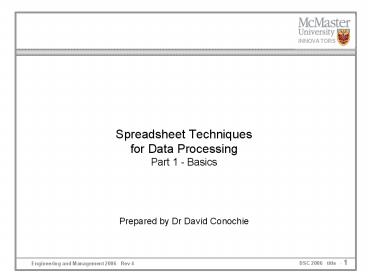DSC 2006 title - 1 PowerPoint PPT Presentation
1 / 16
Title: DSC 2006 title - 1
1
Spreadsheet Techniques for Data ProcessingPart
1 - Basics
- Prepared by Dr David Conochie
2
What is a Spreadsheet?
- Data is arranged in 2D or 3D matrix of cells
- (rows x columns x worksheets)
- Each cell may be of one of the following 4 types
- A value (numeric data)
- A formula ( defines the value of the cell in
terms of other cells and constants. The cell
contains the formula and displays the current
value) - A label (text data or blank)
- A hyperlink
- Each cell may have additional properties
- Formatting of font, background and border
- A comment attached
- Protection
- A variable name associated with the cell
3
Formulae (i)
- Use to start the formula, then type in cell
reference or click on cell. - ((C12) (J17)) 29.3
- Use operators - / , before adding next
cell reference - ((C12) (J17) 29.3
- Use signs to make cell references absolute
- Use functions
- sum(c1c12, c19c27)
- a colon is used to define a range between and
including two cells - a comma is used to separate ranges in the
summation. - ranges can be typed in, or drag the cursor across
a range - select multiple ranges by holding down the cntrl
key. - complete the function with a right bracket.
4
Formulae (ii)
- Exponents and Logarithms
- cell reference 2 is the square of the
value - log(cell reference, base) is log base 10 as
default - ln (cell reference) is natural log
- Row and Column Insertion
- Insert rows within a range and the formula will
include your new data. - Insert row at the end of a range and the formula
will not change - Be very careful and use audit tools!
5
Layout
Adopt a tidy layout
Data Input Table
Title
Physical data and constants
Table with column headers
6
Cell Formula and Auditing Tools
E4Gas_ConstantE7/A14
Precedent Dependent Erase Auditing
Toolbar
7
Example of a Finished Spreadsheet
8
How do spreadsheets work?
- A solver automatically works through the
spreadsheet row by row, cell by cell, then sheet
by sheet - Each time you change a value, the spreadsheet
recalculates. - Cell references in formulae usually take input
from earlier in the sheet but there is usually no
constraint restricting formulae from where input
data is taken. - Recalculation is repeated in an iterative manner
until cells do not change more than a
predetermined amount (say 1 in 1000) or a maximum
number of iterations has been reached. - Cells cannot refer to each other in a circular
reference Excel will tell you immediately if
you try to do this. - During spreadsheet construction Tools \ Options \
Calculation can be used to set manual
recalculation if spreadsheets are big and slow
(seldom used and a big trap).
9
Data Processing
- Spreadsheets are ideal for processing tabulated
data. - Presentation of data in formatted tables
- Calculation of averages, totals, standard
deviation - Charting data for presentation
- Single parameter data (height of students in
class) is presented a bar chart. - Correlated data (fuel consumption, car speed) is
presented as an X-Y chart. - Excel offers the bar chart as the default, but
engineers and scientists mostly use X-Y charts.
10
Charting Data
- Insert , Chart, X-Y (Scatter), then select the
style - Points only
- Smoothed line (beware!)
- Lines connecting points
- Insert chart as a new sheet
11
Assignment EM1 is available on Eng Mgt website
Prepare a quality chart starting from a given
data set.
12
Spreadsheet Techniques for Data ProcessingPart
2 - Advanced
Engineering and Management 2006
- Prepared by Dr David Conochie
13
Logic Functions
- You can build logic into your spreadsheet
functions but use them sparingly. - Logic functions are typically used to
- avoid !DIV0 errors
- switch on error flags if data is outside a range
- to switch on sections of formulae if options are
selected. - If you have much logic in your application, use
the Visual Basic add-in in Excel.
14
Macros and Visual Basic
- If you wish to design a spreadsheet to process
data on numerous occasions, you can use a macro. - Example build a spreadsheet to process data from
the strain gauges on the cantilever beam and
produce a chart. - Work out, or have a trial of the sequence you
wish to reproduce. - Switch on tools, macro, record new macro and give
your macro a name. - Go through the sequence, then stop the macro.
- Use alt f11 to switch to visual basic.
- Under the heading modules you will find the
visual basic commands for your macro. - It is possible to edit these macros, and to write
them in VB without using the record function.
15
Visual Basic Function Example
Function Enthalpy_Solid_Iron(Temp As Double) '
Function for the heat capacity of solid iron '
Inputs... ' Temp Temperature
Kelvins ' Outputs... ' Enthalpy_solid_iron
Ht-H298 kJ/kg Enthalpy_Solid_Iron
(8.873 (Temp - 298) 0.5 0.001474 (Temp
2 - 298 2) _ - 0 (1 / Temp - 1 / 298)
1 / 3 0 (Temp 3 - 298 3) _ - 56.92
2 (Temp 0.5 - 298 0.5)) _ 4.1868 /
55.85 If Temp gt 1058 Then
Enthalpy_Solid_Iron Enthalpy_Solid_Iron 1000
1.22 4.1868 / 55.85 Else End If
If Temp gt 1187 Then Enthalpy_Solid_Iron
Enthalpy_Solid_Iron 1000 0.16 4.1868 /
55.85 Else End If End Function
16
Visual Basic Spreadsheet Data Transfer
VB Variable Sheet Reference Cell Reference
' Bring in unit costs into model.
Electricity_unit_cost Sheets("Unit_costs"
).Cells(24, 4) Electrode_unit_cost
Sheets("Unit_costs").Cells(25, 4)
Lime_flux_unit_cost Sheets("Unit_costs").Cells(2
6, 4) Coal_unit_cost Sheets("Unit_costs"
).Cells(27, 4) Natural_gas_unit_cost
Sheets("Unit_costs").Cells(31, 4) / 1000
Metallurgical_quality_unit_penalty
Sheets("Unit_costs").Cells(21, 4) 1000 'rate
/t

